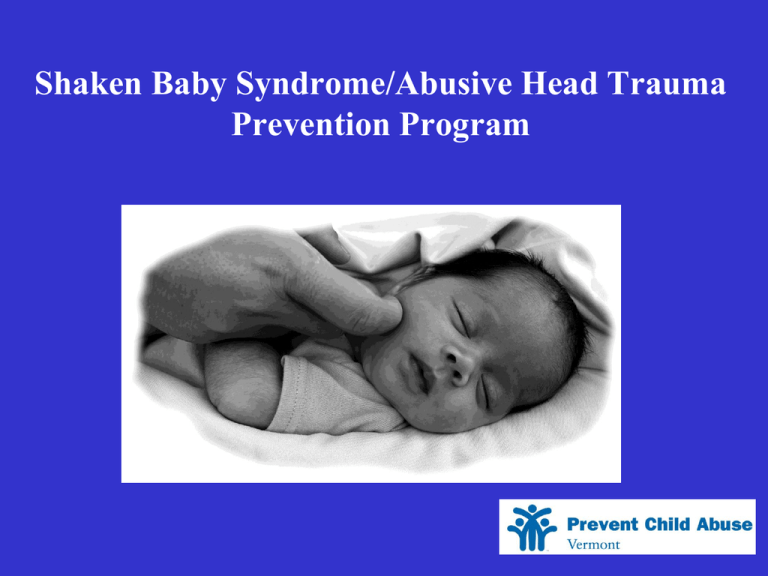Shaken Baby Syndrome Prevention Program
advertisement

Shaken Baby Syndrome/Abusive Head Trauma Prevention Program • Abusive Head Trauma/Shaken baby syndrome (SBS) is the name given to the physical abuse and injuries that occur when an infant or small child is violently shaken and or slammed. • A syndrome is defined as a set of symptoms and physical findings that lead to a certain diagnosis. • These injuries are virtually never seen unless violent whiplash shaking of the head has occurred. • 1700 – 3000 cases diagnosed each year • 0-3 cases in Vermont diagnosed yearly Shaken Baby Syndrome Is NOT Caused By • Tossing a child in the air • Bouncing a baby on your knee • Using a infant swing • Falling or roughhousing • Jogging with your baby The Three Most Common Injuries Caused by Shaking • Intracranial Bleeding- Bleeding on the brain • Cerebral Edema- Massive brain swelling • Retinal Hemorrhages- Bleeding inside the eye Other Injuries Associated with Shaken Baby Syndrome • Rib Fractures • Fractures Long Bones • Skull Fractures Fractures are seen in less than 50% of the shaking victims Rare to find external injuries- bruises Long Term Effects • Severe brain damage • Learning disabilities • Blindness • Paralysis • Seizures • Behavior disorders • Hearing impairments • Physical disabilities • Death 25% of all victims die 50% live with life long Disabilities What We Know About Babies Smaller than Adults Large Heads and Weak Neck Muscles Underdeveloped Brain Signs and Symptoms • • • • Vomiting Irritable/fussy Lethargic Decreased appetite, weak sucking • Increase crying These symptoms be seen in infants and small children with other illnesses. • Seizures • Rigid posture • Head or forehead appears larger, bulging soft spots • Inability to focus eyes / pupil changes • Decreased level of consciousness • Difficulty Breathing Victim Gender 60 % Male 40 % Female Victim Age Most victims of SBS are less than 1 year old Majority being under 6 months of age Cases of children up to 3 years of age SBS Perpetrators 70-80 % are young Males (18-28), with the most being the biological father of the victim or the mother’s boyfriend. Even though the majority of SBS perpetrators are male, it would be very dangerous to assume that anyone is exempt! Anyone who can become frustrated is capable of shaking a child. There is no traditional profile . One cannot look at socioeconomic status, education, history of drug use or abusive background to determine if one is likely to endanger a child by shaking. What triggers Shaking? Inconsolable Crying • Resistant to soothing • After being fed, changed, burped, rocked • Inability of caregiver to cope with this frustration that can lead to abuse behavior All Babies Cry • Crying begins around 2 weeks, peeks at 2 months and starts to decrease at 3-4 months • All babies cry, some more than others, and it’s OK • Remember it is not your fault, and don’t take it personally! Why Babies Cry Communicates Needs Hungry? Doesn’t know Tired? Misses parent Too Warm/Cold? Over stimulated Wet? Bored? Sick? Ways to Soothe a Crying Baby Feed Baby Change Diaper Check Clothing Play with your baby Try vacuuming Put baby in Swing/Bouncer Turn on music Give him a bath Go for a ride in car Sing, dance, or go for a walk Hint: No Baby has ever died from crying it is ok to let a baby cry! Tips for Quieting A Crying Baby Wrap the baby snugly in a warm, soft blanket and gently rub the baby’s back while lying on its side or tummy on your lap Talk, sing, play music, turn on the vacuum or a static TV channel, or play with a noisy toy in front of the baby Rock, dance or try a baby swing. Take the baby outside for some fresh air, a ride in the stroller or in the car in the car seat Try feeding the baby, offering a bottle, breast, or try a pacifier Give the baby a warm bath Stay calm and speak softly to your baby Sometimes these tips do not work Place the baby on his back in a safe place like the crib and walk away if you are feeling frustrated or angry. Give yourself and your baby a break. Check on the baby every 10-15 minutes. Count to ten Listen to music Exercise Watch TV Call a friend, family member, or helpline STRESS……….. Symptoms Causes Irritability, headache, fatigue, racing heartbeat, yelling, swearing, losing or gaining weight, feel like punching something? Jobs, relationships, family, responsibility, crying baby, bills, and just life. Management Stay healthy,walk away, exercise, listen to music, take deep breaths, find time for yourself, smile, call a friend and ask for help! How Can We Keep Our Children Safe? •Never leave your child with someone who may be stressed. •Make sure your child’s caregiver knows it is never ok to shake your baby. •Know your own limitations. •Have a safety plan before you can no longer tolerate your child’s crying. NEVER SHAKE A BABY In a few seconds of anger and frustration your life and child’s life could change forever! It is ok to let a baby cry! A baby has never died from crying! It is never okay to shake a babyserious injury or death can occur. This program is generously supported by grants from: Department of Disabilities, Aging and independent Living Department for Children and Families Department of Health Never Shake A Baby 1-800-CHILDREN 1-800-244-5373 Resources The National Center on Shaken Baby Syndrome www.dontshake.org Dr. Harvey Karp –The Happiest Baby on the Block www.thehappiestbaby.com





